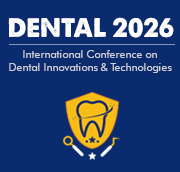Title : Unicystic Ameloblastoma mimicking Periodontal lateral cyst: A rare case report.
Abstract:
Intraosseous unicystic ameloblastoma (UA) is rare subtype of a true neoplasm of odontogenic epithelial origin: ameloblastoma. The minimum criteria to diagnose an UA is the presence of a single cystic sac lines by variable epithelium: ranging from typical ameloblastic to metaplastic epithelium (consisting of no keratinizing squamous cells layer). UA present three histological subtypes according to the growing of ameloblastoma cells:
• luminal showing a flat ameloblastic cyst lining;
• Intraluminal characterized by a tumor growth into the cyst lumen;
• Mural exhibiting infiltrating growth into the wall of the cyst and even beyond into the surrounding bone.
The recurrence risk of the mural subtype is the highest, followed by the luminal and intraluminal UA. However, UA remains a rare lesion; representing 15% of ameloblastoma, itself representing 9% to 10% of odontogenic tumors.
Despite its rareness, dealing with UA is problematic. It is usually mistaken with an odontogenic cyst, and biopsy is rarely relevant because multiple grow patterns can exist inside one lesion. The biggest challenge remains the treatment choice: whether conservative or radical, it is usually controversial, since it depends on pathology results which may reveal only one of the multiple growth patterns of a lesion and mural treatment must be well balanced. Commonly, invasive approach is the chosen therapy for the highest recurrence rate subtype and conservative treatment is recommended for the less recurrent ones. However, opting for an invasive procedure must be well-thought-out and requires a balanced judgment, so its success doesn’t lead to an overtreatment. Therefore, when we are facing a lesion that strongly evoke a periodontal latera cyst, we must keep in mind the possibility of an UA which is locally aggressive and has high risk of recurrence. In our case, finding the balance between the aspect of the lesion, patient’s young age, psychological fragility, post operation process and biopsy diagnostic needs was our dilemma. Our patient is a 23 years old men with a mural unicystic ameloblastoma, diagnosed with general anxiety disorder. The final decision was to turn to a simple enucleation because of the small size of the lesion, and its radiological features strongly evoked a periodontal lateral cyst. Aside clinical arguments, patient’s young age and his psychological condition were in favor of a conservative treatment. Caronoy’s solution was not used to decrease the risk of recurrence since the lesion destructed the cortical in some portions, becoming in contact with soft tissues and the alveolar vascular nervous plexus. Marsupialization also was not an option because of the small size of our lesion, besides, even if the aspect of the lesion strongly evoked a periodontal lateral cyst, the possibility of an ameloblastoma was in mind. Therefore, we needed to present the entire specimen to the biopsy exam. Two years later, no sign of radiological recurrence was noted. However, we are aware of a later resection eventuality in case of recurrence.



